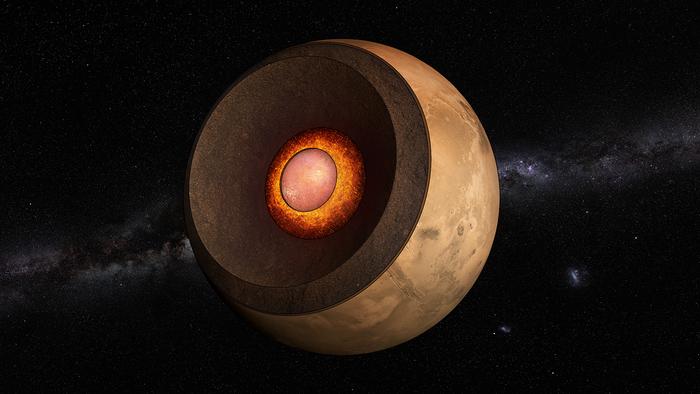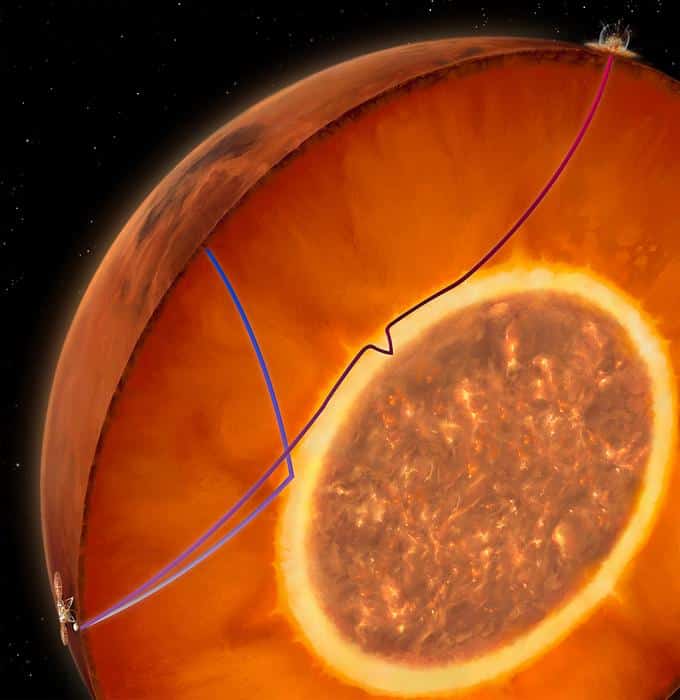
New findings published in Nature have reshaped our understanding of Mars in a way that could explain many longstanding mysteries about the Red Planet. An international team of researchers, armed with data from NASA’s InSight lander, have uncovered a molten silicate layer at the base of the Martian mantle, a discovery that is set to revolutionize our knowledge of Mars’ internal structure.
This newly discovered layer, measuring approximately 150 kilometers thick, sits just above Mars’ metallic core. While its existence might seem like a mere geological detail, this layer answers several pressing questions about the Red Planet.
Initial estimates had placed the Martian core’s radius between 1,800-1,850 km (1,118-1,150 miles). With this groundbreaking discovery, scientists now believe the core’s radius is significantly smaller, falling between 1,650-1,700 km (1,025-1,056 miles). To give a sense of scale, that’s roughly half the entire radius of Mars.
What sparked this revelation? The key lay in analyzing Mars’ seismic activity. Earlier, data from marsquakes detected near the InSight lander were the primary sources of information about the Martian core. However, 2021 brought a game-changing moment: the InSight lander detected two significant marsquakes, one caused by a meteorite impact originating from the planet’s opposite side. These quakes sent seismic waves through the Martian core, revealing its secrets in greater detail.

The findings were unexpected. When analyzing marsquake data combined with computer simulations, researchers found that the Martian core’s average density was far lower than anticipated for a structure primarily made of liquid iron. For perspective, while Earth’s core comprises about 90% iron (with light elements making up the rest), Mars’ core appears to have a staggering 20% of these light elements.
This discrepancy has left experts like Dongyang Huang, a senior scientist at ETH Zurich and a study author, puzzled for some time.
“This represents a very large complement of light elements, bordering on the impossible,” Huang said. “We have been wondering about this result ever since.”
However, the new findings provide a clearer perspective. The molten layer can be likened to a “heating blanket” encompassing the Martian core. Beyond keeping the core warm, this layer captures radioactive materials, intensifying the core’s heat.
“The blanket not only insulates the heat coming from the core and prevents the core from cooling, but also concentrates radioactive elements whose decay generates heat,” said Vedran Lekic, a geology professor at the University of Maryland and study author.
One significant implication of this molten layer is its impact on Mars’ magnetic field—or the lack of it. Lekic suggests that the intense heat from this layer could prevent the core’s convective motions, essential for generating magnetic fields. Consequently, Mars remains exposed to potent solar winds, which might explain its desolate appearance.
A functional magnetic field is pivotal in protecting terrestrial planets from solar winds. Without it, a planet like Mars stands vulnerable, losing surface water and rendering it inhospitable. The disparities between Earth and Mars could stem from their unique internal structures and evolutionary paths.
“The thermal blanketing of Mars’s metallic core by the liquid layer at the base of the mantle implies that external sources are necessary to generate the magnetic field recorded in the Martian crust during the first 500-800 million years of its evolution,” said Henri Samuel, a researcher at the Earth Physics Institute in Paris and study author.
“These sources could be energetic impacts, or core motion generated by gravitational interactions with ancient satellites which have since then disappeared.”
Aligning with this, the research team’s findings resonate with the theory that Mars was once a vast magma ocean. As it cooled, a silicate layer, enriched with radioactive elements and iron, formed. This transformation would have considerably impacted Mars’ thermal evolution.
Lekic says the findings could shed light on future cosmic observations.
“These layers, if widespread, can have pretty big consequences for the rest of the planet,” he said. “Their existence can help tell us whether magnetic fields can be generated and maintained, how planets cool over time, and also how the dynamics of their interiors change over time. We hope that the information we’ve gathered on planetary evolution using seismic data is paving the way for future missions to celestial bodies like the moon and other planets like Venus.”






